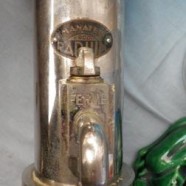Marie Curie’s radioactive waste
Marie Curie was an outstanding researcher and an adventuress of the atom. The President of the Republic chose to pay tribute again to the one who received the Nobel Prize in Chemistry for having discovered radium.
A century after this discovery, dozens of areas are polluted by radium residues throughout France. The location of these sites, radiological control, and extraction of contaminated materials consume a lot of money and time and face a major liability: lack of storage sites for radioactive waste from the first generation.
Radium Water fountains: The hunt is open in the Lyon-Villeurbanne region
Radium water fountains or radium vaporizers were used in the first half of the twentieth century to enrich the water with radon, descendant of radium. In this time period, they didn’t mistrust radioactive gas but rather boasted of its virtues.
Today these ornamental objects find themselves in attics, flea markets, and bric-a-brac sales.
Freezing. Will they hold out?
Long periods of climatic cooling were dismissed by EDF (Electricity of France) and other managers of nuclear installations of Complimentary Evaluations of Safety post-Fukushima.
Plutonium for Martians
Whatever life forms are on planet Mars, they will have to deal with plutonium-238 produced by American atomic research labs if the Mars Science Laboratory Curiosity mission succeeds. The launch is scheduled for Saturday, November 26th from Cape Canaveral, Florida.
The plutonium-based radio-isotopic generator that powers the Curiosity robot will become an out-of-commission vehicle on the Martian surface after 23 months of activity and exploration. It will leave a lot laboratory waste and its 4.6kg of 238Pu. The half-life of 238Pu is 87.7 years. 264 years after its production, it gives off another 12.5%. If Mars is the subject of colonization experimental within the next century, pioneers risk being exposed to radioactive contamination of human origin dating from 2012 or 1975 with the landing of the Viking probes. Do not forget that the surface and the atmosphere of Mars have been poisoned by at least 5 other crashed probes each powered by a plutonium battery amounting to hundreds of grams.
Nuclear waste
The return of nuclear waste in Germany is legitimate. This waste is an inevitable byproduct of reprocessing spent fuel from German nuclear reactors. The return of waste conforms to contracts signed by the German and French nuclear industries as well as their respective governments.
Each country that took the decision to invest in the nuclear industry and prefers reprocessing is responsible for the waste. European countries use the reprocessing plant in La Hague Peninsula as a means to differ national management of nuclear waste. Until further notice, Germany decided to abandon nuclear power. This does not lessen the country’s responsibility of all nuclear waste that was produced in Germany by itself or its foreign subcontractors. Leaving nuclear power imposes both reflection and a call to action on waste management of production and dismantling materials.












